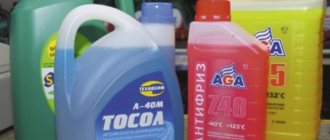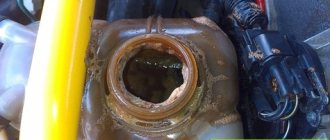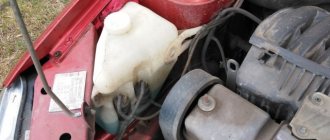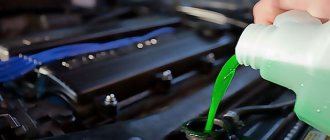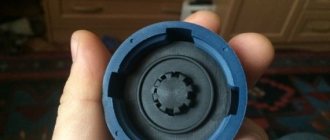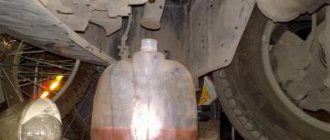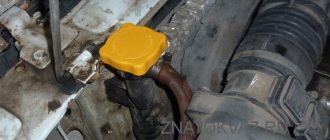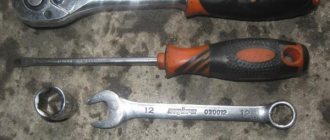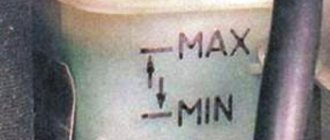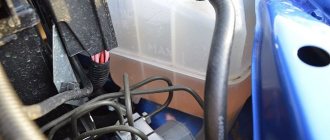Why do you need to drain the coolant?
The cooling system of modern cars uses antifreeze as a heat transfer fluid. At first glance, it may seem that this fluid does not need to be replaced, because the system is closed and nothing gets into it from the outside. The main components of antifreeze are ethylene glycol and water, but no less important are additives that prevent corrosion of cooling system elements, lubricate and protect them. As the vehicle is used, the additives lose their properties, which leads to the formation of corrosion with subsequent disruption of the performance of parts. As a result, particles of metal and other materials settle and clog the radiator and other system components. This leads to deterioration in engine cooling and, as a result, to overheating.
When to change antifreeze
Antifreeze must be replaced in several cases:
- Loss of coolant characteristics. This happens due to constant temperature changes, evaporation, and oxidation.
- Adding water or other liquid to antifreeze in emergency cases. There are situations when, due to boiling antifreeze or other reasons, additional liquid is required, but there is simply none at hand. Therefore, ordinary water or antifreeze of a different class or brand is often used. After such manipulations, the antifreeze needs to be completely replaced.
When adding water or antifreeze of another brand to antifreeze in emergency cases, it is recommended to replace the coolant - Carrying out repairs. If repair work was carried out on the cooling system or engine, which required draining the coolant, it is advisable to use new antifreeze to subsequently fill the system.
Antifreeze resource
Antifreeze, like any other technical liquid, has a certain service life, which is indicated by the manufacturer or automaker. Basically, antifreeze is changed every 2-3 years. If we talk about modern cars, the coolant is changed when it has been in use for more than 5 years or a mileage of 250 thousand km, which is typical for Volkswagen cars. AvtoVAZ stipulates replacement after 75 thousand km. or 3 years of antifreeze operation.
Signs of coolant replacement
The following signs indicate the need to replace antifreeze:
- the liquid loses its original color and becomes brownish. This indicates corrosion of system parts. Such antifreeze needs immediate replacement, regardless of its service life;
If the original color is lost, the antifreeze must be replaced - A jelly-like coating appears on the inside of the expansion tank neck. When the temperature drops to -10–15 °C, sediment and cloudiness appear in the container, and the radiator fan begins to operate more often.
How to properly replace antifreeze on a VAZ 2114?
The question of how to replace antifreeze on a VAZ 2114 is resolved in the standard manner. First of all, pay attention to the relevance of these actions. The reason for replacing the coolant may be one of the following factors:
- The service life of the filled antifreeze has expired;
- a leak is detected, the components of the system are repaired or replaced;
- the color of the coolant has changed, foreign impurities have appeared;
- The engine constantly overheats, the antifreeze cannot cope with cooling and gradually boils away.
If during a preventive inspection a low quality coolant is revealed, replacement is carried out with mandatory flushing of the system. It is also relevant if the brand and color of the consumable changes.
When it comes to the frequency of scheduled replacement of antifreeze on the VAZ 2114, they are guided by the service life of the coolant itself. In a car purchased from the manufacturer, it is changed after 60 thousand kilometers . The service life of a replacement consumable is determined by the canister; it is usually 5 years .
When replacing antifreeze on a VAZ 2114, pay attention to certain safety rules :
- all manipulations are carried out with a cooled engine - this avoids thermal burns and high pressure;
- when cooling, the pressure decreases, however, its presence should be taken into account when opening the covers and plugs of the system - splashes and coolant getting on your hands and face are possible;
- antifreeze has a high level of toxicity, it is not allowed to enter the soil; special containers are used to drain coolant and flush water;
- limit the presence of children and animals nearby that can interact with antifreeze.
Taking into account the above factors, the list of tools for replacing antifreeze in the VAZ 2114 includes the following equipment :
- rubber gloves, clean rag;
- a set of keys and screwdrivers, pliers, if possible, a compressor and a pumping bulb;
- drainage container with a volume of 7 liters or more. additional container for rinsing water;
- consumables - new antifreeze, distilled water, optional cleaning agent.
It is also recommended that you first inspect the entire cooling system for worn parts that may soon require replacement. In order not to change the coolant in the near future due to system components, it is recommended to carry out their preventive replacement at the same time as the antifreeze.
All consumables should be purchased only from authorized dealers and trusted suppliers in accordance with the manufacturer’s recommendations for vehicle maintenance. To do this, refer to the technical documentation and identify the original part numbers.
Stage one
Antifreeze is drained from the VAZ 2114 according to the following scheme:
- The car is parked on level ground and, if available, a repair pit or lift is used;
- if the engine has not been running for a long time, it is warmed up for better coolant circulation;
- as additional precautions, remove the minus from the battery, and also cover the generator to prevent antifreeze from getting on it;
- if there is additional engine protection and a protective casing, remove them;
- carefully, taking into account the possible pressure in the system, uncork the radiator and expansion tank caps;
- in the cabin, the heater tap is moved to the right to the maximum to ensure complete drainage of the coolant;
- there is a drain plug in the lower left part of the radiator - place a container under it for draining; before opening it, you should also make sure that the generator is protected from possible ingress of antifreeze;
- to drain the coolant from the cylinder block, you will need to dismantle the ignition module - it is secured with three bolts, the operation does not take much time;
- Place a container under the drain from the cylinder block and unscrew the plug.
Depending on the engine size, about 7 liters of used antifreeze leaks out. To speed up the procedure and ensure complete drainage, some car owners blow out the system with a compressor. Warming up the engine briefly for better circulation also helps. Remains from the expansion tank can be pumped out using a syringe or bulb.
Stage two
To flush the cooling system, use a special product or distilled water. When using the first option, repeated rinsing with water will be required, so many car owners and specialists do not use washing mixtures.
We recommend: How to fix poor heating of the Daewoo Nexia stove
The general washing procedure involves the following stages:
- the lower drains are temporarily tightened, the system is restored to its original form;
- add washing agent or distilled water;
- warm up the engine to operating temperature, turn it off, and allow it to cool;
- drain the rinse in the same way as used antifreeze, repeat the procedure until the water at the outlet remains relatively clean.
Many car owners simplify the cleaning procedure by leaving the bottom drains open and feeding regular water from a hose into the system under medium pressure. This method allows you to avoid constant manipulation of connections and periodic warming up of the engine, but does not guarantee high-quality cleaning of the system.
Stage three
Filling antifreeze for the VAZ 2114 does not have key features that distinguish the process from a similar procedure with other cars. The only nuance is the removal of the coolant supply hose to prevent the formation of air locks.
To replace antifreeze after draining and flushing, the system is returned to its original state and the tightness of the fasteners is checked. After disconnecting the supply hose, new coolant begins to be poured into the radiator. As soon as it flows from the disconnected hose, it is returned to its place.
Next, antifreeze is poured into the expansion tank to the mark indicating the upper limit. Filling is carried out with a thin stream, periodically squeezing the pumping hoses to remove air bubbles.
After filling, screw on the radiator and expansion tank caps, and warm up the engine to operating temperature. The circulation of coolant from the first warm-up will reduce its level in the tank - after the engine has cooled, antifreeze is again added to the maximum.
After 100-200 km, the condition of the coolant should be checked again. Pay attention to the decrease in level - if necessary, add the required amount again and check the system for loose connections and possible leaks. If the color of the new antifreeze has changed, a reddish, brown or black tint has appeared - this is a low-quality product that should be urgently replaced with mandatory flushing of the system.
How to prepare a car for draining coolant
To drain the antifreeze, you need to perform some preparatory measures. Since the substance in question is toxic, it should not be dumped on the ground. For these purposes, resealable containers are used, which are disposed of in accordance with environmental standards. Preparing the car consists of placing it on a flat horizontal surface to more effectively drain fluid from all pipes and components. On almost all cars, the coolant is drained through a special hole, which is sometimes located in the lower part of the radiator or on the pipes.
If there is no hole, drainage is carried out through the removed radiator pipe.
If there is no drain hole, the coolant is drained through the radiator pipe
An important point is compliance with safety precautions: draining antifreeze from a hot engine is strictly prohibited. Due to the high heating temperature of antifreeze, there is a high probability of getting burns during operation. In addition, as a result of heating, the liquid in the system is under pressure and when any lid is opened, it will be released. Therefore, you first need to wait until the engine cools down to ambient temperature and only then unscrew the cap of the expansion tank and radiator.
Flushing
Many experts agree that the system should be flushed before replacing the coolant. But how to do this and is such an event really mandatory?
If the coolant being drained shows signs of rust and contamination, then the system should still be flushed. This preventive measure will never be superfluous. Therefore, try to allocate some of your precious time to the procedure. The engine will remain grateful to you.
Expansion tank
The cooling system is washed quite easily:
- Drain the old fluid by unscrewing the drain plug;
- Fill the system with water through the filler neck;
- Distilled or boiled water can be used as a washing composition. Plus, there are special cleaning compounds. They are more expensive, but their efficiency is higher;
- Start the engine with flushing water inside and let it idle for about 30 minutes;
- Drain;
- If it is very dirty, repeat the procedure;
- Add new coolant to the system.
We recommend: Tire load index - meaning of symbols
Is there a difference in the processes of draining antifreeze in eight- and sixteen-valve engines?
There is a difference, and it is significant. The fact is that the “tens” engines have different designs. In terms of draining antifreeze, a VAZ-2110 with 8 valves is more convenient than a dozen with sixteen valves. The first has a coolant drain plug located on the front of the cylinder block. To get to it, you don’t need to drive the car into the inspection hole or remove the protection. But for sixteen-valve power units, the plug is located at the bottom, and can even be closed by the starter, so before draining the antifreeze from the VAZ-2110, you will need to drive the car into a pit (overpass), remove both the protection and the starter. Let's take a closer look at this process for each engine.
ABOUT THE PRINCIPLE OF OPERATION OF THE COOLING SYSTEM
The engines of the family vehicles are combined with a closed-type liquid cooling system. There are special channels in the engine cylinder block through which coolant, or coolant for short, circulates, which is used as antifreeze, antifreeze or water. Moving through the block, the coolant takes away excess heat and enters the radiator for cooling.
Studies of the operation of internal combustion engines have shown that the normal temperature for optimal engine operation should be 90 0 C. To maintain a constant such temperature, a thermostat is installed in the system. During engine operation, it redirects the coolant flow to the radiator for cooling, or again to the cylinder block.
Forced coolant circulation in the system is provided by a pump, which is driven by a drive belt from a pulley on the engine crankshaft. The heated coolant flows through the pipes into the radiator for cooling. It comes from the flow of oncoming air, and if it is not enough, then the electric fan turns on. Also, hot coolant enters the heater radiator to heat the engine compartment, and its excess during thermal expansion is sent to the expansion tank.
